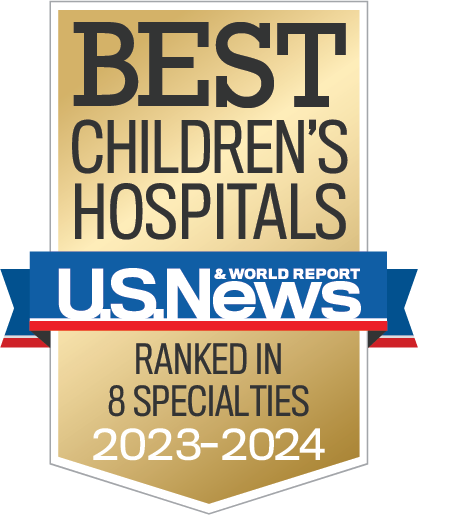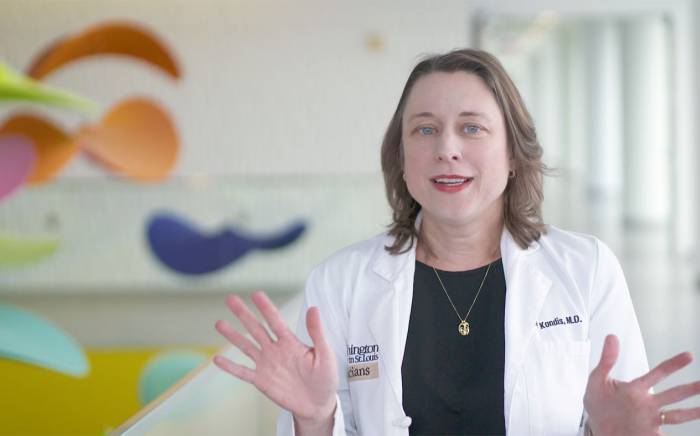If your child was born with a defect affecting the heart’s structure, your child’s heart may not pump blood effectively throughout the body. At the St. Louis Children’s and Washington University Heart Center, we can help. Our doctors offer care to treat and help manage heart valve and other structural heart diseases, so that your child can live a healthy, active life.
Heart Valve Care: Our Approach to Treatment
Our doctors are among the most renowned in the world for their skill and knowledge of successful heart valve replacement procedures. New developments, some of which our doctors helped pioneer, now allow us to replace defective heart valves using minimally invasive techniques.
We perform these catheter-based procedures in our Cardiac Catheterization Lab, one of the top programs of its kind in the nation and a referral center for infants and children battling heart conditions. Learn more about the pediatric heart conditions we treat.
Heart valve replacement can delay or avoid the need for open-heart surgery for your child. Our goal is to find the least invasive avenue for the most effective, longest lasting treatment. With every heart valve procedure we perform, we offer the highest level of care for the best possible outcomes for your child.
Harmony™ Transcatheter Pulmonary Valve (TPV)
Our Washington University interventional cardiologists at St. Louis Children's Hospital are the first in the region to implant the Harmony™ valve. This is an FDA approved valve that can be delivered through a catheter and is designed to replace a leaky pulmonary valve. Many patients who have had surgery for congenital heart defects will have a leaky pulmonary valve. Over time this can result in progressive enlargement of the right side of the heart. In order to treat this, a new valve will need to be placed. This can be done either surgically or in the cardiac catheterization lab if the patient is a suitable candidate. For many patients however, the area where the valve is to be implanted was too large for currently available valves. The Harmony™ valve has overcome this limitation for many of these patients. It is a valve specifically designed to be delivered through a catheter, avoiding open heart surgery, and is intended to treat patients who have a very large pulmonary artery and who were not previously candidates for this procedure.
Percutaneous Heart Valve Replacement: Our Innovations
In 2010, the U.S. Food and Drug Administration (FDA) approved the use of a new valve for children and adults born with a pulmonary valve defect. This device, along with some others currently being studied, can be implanted via cardiac catheterization, avoiding the need for open-heart surgery.
Our catheterization doctors, among the most renowned in the world for their skill and knowledge, were among the select group of teams that developed the new valve technology. We continue to supervise and teach programs around the country, with doctors who wish to develop the same.
Our doctors have developed a comprehensive, personalized program of care that we tailor to each patient’s needs. We are the first program in the region to successfully perform a hybrid valve replacement procedure in a high-risk patient. In a hybrid procedure, our surgeons and catheterization doctors work together in a procedure combining open-heart surgery with cardiac catheterization to replace the valve.
Percutaneous Heart Valve Replacement at St. Louis Children’s Hospital
Most heart valve problems in children result from congenital heart defects (heart defects that your child was born with). Some heart valve conditions include:
- Stenosis: A narrowed valve that prevents adequate blood flow through the heart and to the rest of the body, caused by valve flaps that developed abnormally or are too stiff to open all the way. Learn more about aortic stenosis and pulmonary stenosis.
- Regurgitation: A leaking valve that does not close properly, allowing blood to flow backward.
- Tetralogy of Fallot: A congenital heart defect involving four structural defects in the heart. Learn more about Tetralogy of Fallot.
Using minimally invasive procedures, we can replace the defective valve while the heart is still beating. These procedures involve cardiac catheterization using catheters (thin, flexible tubes) inserted into a blood vessel and guided to the heart.
This technique is called transcatheter valve replacement, and its benefits compared with open-heart surgery include:
- Shorter hospital stays (24 hours vs. 3 days)
- Possibly lower risk of complications
- Faster recovery time













